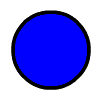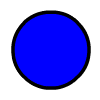Key frame
Il termine inglese key frame (traducibile in italiano come fotogramma chiave) è un tipo di fotogramma che definisce lo stato iniziale, intermedio e finale di un'animazione. Una volta stabiliti i key frame, è possibile creare i fotogrammi intermedi, operazione definita inbetweening (intercalazione).
Nell'animazione tradizionale, i key frame sono generalmente disegnati dai key animator (animatori chiave), e il lavoro di creare i fotogrammi intermedi viene affidato agli inbetweener (intercalatori). Lo stesso capita nell'animazione al computer, dove l'animatore stabilisce i key frame, mentre le operazioni di inbetweening vengono svolte automaticamente dai software. Questa tecnica, denominata keyframing, viene impiegata per transizioni riferite al movimento, alla forma (utilizzando anche "indicazioni" denominate "shape hints") e al colore.
Nel digital video
Si usano i keyframes nella produzione dei video digitali, sia 3D che 2D, sia su computer che su dispositivi mobili.



Nel web

Nel web ci sono diverse tecniche per creare animazioni tramite keyframes:
CSS3
Esempio:
div {
width: 100px;
height: 100px;
background: red;
position: relative;
animation: filmato 5s infinite;
}
@keyframes filmato {
from {top: 0px;}
to {top: 200px;}
}
Canvas HTML5
Esempio:
window.requestAnimFrame =
window.requestAnimationFrame ||
window.webkitRequestAnimationFrame ||
window.mozRequestAnimationFrame ||
window.oRequestAnimationFrame ||
window.msRequestAnimationFrame ||
function (callback) {
window.setTimeout(callback, 1000 / 60);
};
WebGL
Esempio:
var keys = [0, 0.25, 1];
var values = [new THREE.Vector3(0, 0, 0),
new THREE.Vector3(0, 1, 0),
new THREE.Vector3(0, 2, 5)];
SVG
Esempio con CSS3:
.left-leg {
animation: danza 2s infinite alternate;
}
@keyframes danza {
100% {
transform: rotate(3deg);
}
}
Esempio con SMIL:
<svg viewBox="0 0 127.9 178.4">
<path d="M37.6,138.8c0 ... ">
<animate attributeName="fill" dur="5000ms" to="#f06d06" fill="freeze" />
</path>
</svg>
Adobe Flash
Obsoleto dal 31 dicembre 2020

GIF

X3D
Esempio:
<x3d width='500px' height='400px'>
<scene>
<transform DEF="ball">
<shape>
<appearance>
<material diffuseColor='1 0 0'> </material>
</appearance>
<sphere></sphere>
</shape>
</transform>
</scene>
</x3d>
O3D
Esempio:
if s % config['n_keyframes_per_n_frame'] == 0 \
and t % config['n_keyframes_per_n_frame'] == 0:
print(
"Fragment %03d / %03d :: RGBD matching between frame : %d and %d"
% (fragment_id, n_fragments - 1, s, t))
[success, trans,
info] = register_one_rgbd_pair(s, t, color_files, depth_files,
intrinsic, with_opencv, config)
OpenGL
Esempio:
struct MyVertex_VNTVN
{
float x, y, z;
float nx, ny, nz;
float s0, t0;
float x1, y1, z1;
float nx1, ny1, nz1;
}
Esempi
- Transizione di movimento utilizzando i keyframe
- Keyframe iniziale
- Keyframe finale
- Animazione completa
- Transizione di forma utilizzando i keyframe (senza shape hints)
- Keyframe iniziale
- Keyframe finale
- Animazione completa
- Transizione di forma utilizzando i keyframe (con shape hints)
- Keyframe iniziale
- Keyframe finale
- Animazione completa
- Trasformazione di colore utilizzando i key frame
- Keyframe iniziale
- Keyframe finale
- Animazione completa
Note
Voci correlate
Altri progetti
 Wikimedia Commons contiene immagini o altri file sul Key frame
Wikimedia Commons contiene immagini o altri file sul Key frame











